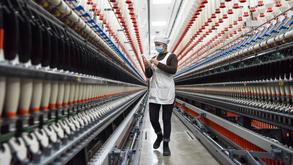 A staff member works in a textile factory at the integrated industrial park in Moyu County of Hotan, northwest China's Xinjiang Uygur autonomous region, Jan 11, 2022. (DING LEI / XINHUA)
A staff member works in a textile factory at the integrated industrial park in Moyu County of Hotan, northwest China's Xinjiang Uygur autonomous region, Jan 11, 2022. (DING LEI / XINHUA)
BEIJING - China's economy has gradually overcome the negative impacts of the epidemic, with main indicators showing marginal improvement in May, Fu Linghui, spokesperson for the National Bureau of Statistics, said Wednesday.
"The economy is showing a good recovery momentum," Fu said at a press conference, but he warned that the economic recovery still faces many difficulties and challenges.
The value-added industrial output, an important economic indicator, went up 0.7 percent year-on-year in May, NBS data showed.
On a monthly basis, the industrial output in May registered an increase of 5.61 percent, according to the data.
Given that the COVID-19 has dealt a blow to many firms, Fu Linghui, spokesperson for the National Bureau of Statistics, said China will further implement relief measures, expand domestic demand and improve the business environment to support the industrial economy
"Due to continued efforts to resume work and stabilize key industrial and supply chains, May's industrial output saw positive changes with the growth reversing the downward trajectory," Fu said.
The equipment manufacturing sector saw its output rise by 1.1 percent year-on-year, compared with an 8.1-percent decline in April, Fu noted.
Mining output climbed by 7 percent from the previous year. The output of the manufacturing sector rose 0.1 percent, and the production and supply of electricity, heat, gas and water inched up 0.2 percent.
The output of new energy vehicles surged 108.3 percent, while that of solar batteries increased 31.4 percent year-on-year, according to the NBS data.
China's exports grew by 15.3 percent year-on-year in May, picking up from the previous month.
The recovery signs indicate that China's industrial transformation and upgrading trend has not changed, Fu said, adding that the industrial production is expected to accelerate recovery as the pro-growth measures are taking effect.
Given that the COVID-19 has dealt a blow to many firms, Fu said China will further implement relief measures, expand domestic demand and improve the business environment to support the industrial economy.
The industrial output measures the activity of large enterprises each with an annual main business revenue of at least 20 million yuan ($3 million).
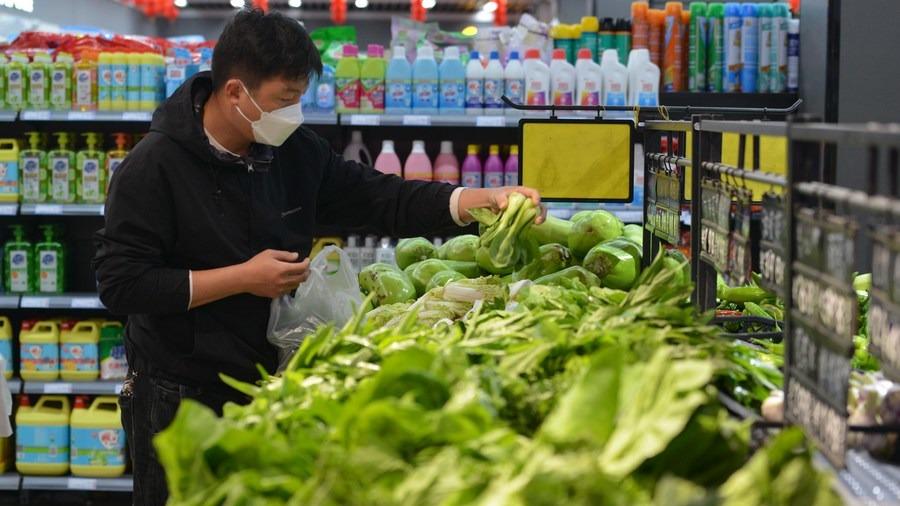 A customer buys vegetables at a supermarket in Linquan county, East China's Anhui province, May 11, 2022. (LU QIJIAN / XINHUA)
A customer buys vegetables at a supermarket in Linquan county, East China's Anhui province, May 11, 2022. (LU QIJIAN / XINHUA)
China's retail sales of consumer goods amounted to 17.17 trillion yuan during the period, data from the National Bureau of Statistics showed
Retail sales narrows contraction
Meanwhile, the retail sales of consumer goods went down 1.5 percent year-on-year in the first five months of this year, the NBS said.
The country's retail sales of consumer goods, a major indicator of consumption growth, went down 6.7 percent from a year ago in May to 3.35 trillion yuan, according to NBS data.
The decrease narrowed by 4.4 percentage points from the previous month, data showed.
In the January-May period, China's retail sales of consumer goods stood at 17.17 trillion yuan, down 1.5 percent year-on-year.
China's domestic demand has recovered last month, Fu said, attributing the smaller decline to improving the epidemic situation and business activities, as well as government policies designed to spur investment and consumption.
ALSO READ: China's retail sales boom during Dragon Boat Festival
Last month, sales of daily necessities sustained steady growth. Beverage sales of major enterprises jumped 7.7 percent year-on-year in May, and sales of grain, edible oil and other food products rose 12.3 percent, NBS data showed.
Fu Linghui, spokesperson for the National Bureau of Statistics, expected consumption to become a stronger driver of China's economic growth, saying that consumption will recover at a faster pace as people's life return to normal
Online consumption continued to shore up retail sales. In the first five months, online sales of physical goods climbed 5.6 percent, with its proportion of retail sales increasing.
Sales of major supermarkets grew 4 percent year-on-year in the January-May period, while that of convenience stores rose 4.7 percent from a year ago, data showed.
The catering sector, one of the sectors hit hard by COVID-19, saw its revenues fall 8.5 percent year-on-year in the first five months.
Fu expected consumption to become a stronger driver of China's economic growth, saying that consumption will recover at a faster pace as people's life return to normal.
"Consumption is still recovering from the fallout of the epidemic and will continue the momentum with employment remaining stable," Fu said.
"China is expected to register a reasonable economic growth in the second quarter if the epidemic is effectively controlled and the pro-growth measures are taking effect," the spokesperson said.
Noting that consumption remains weak and employment remains under pressure, Wen Bin, chief analyst at China Minsheng Bank, urged greater efforts to boost domestic demand and employment, give bailouts to industries and individuals in trouble, and improve confidence among market entities.
Looking into the future, the country will effectively coordinate epidemic prevention with economic and social development, step up macro policy adjustments, and make every effort to ensure the implementation of pro-growth policies to promote sustained economic recovery, Fu said.
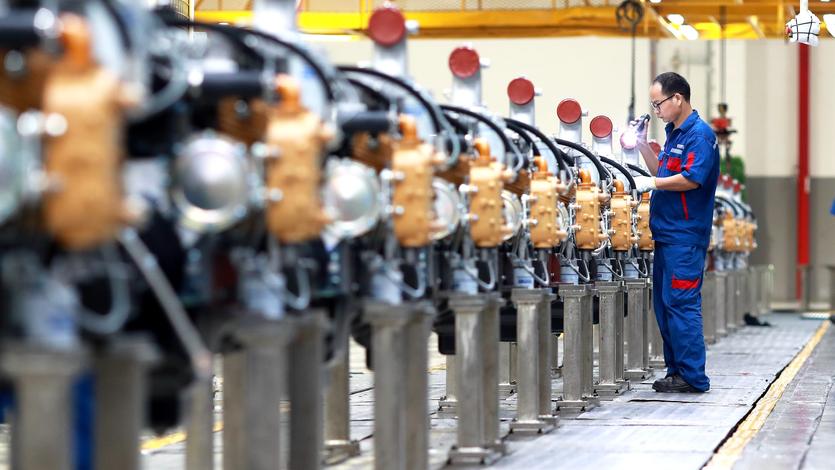 A worker checks engines at a Guangxi Yuchai Machinery Group Co Ltd facility in Yulin, Guangxi Zhuang autonomous region, in September 2021. (PHOTO / XINHUA)
A worker checks engines at a Guangxi Yuchai Machinery Group Co Ltd facility in Yulin, Guangxi Zhuang autonomous region, in September 2021. (PHOTO / XINHUA)
Steady growth in fixed-asset investment
NBS data also showed China's fixed-asset investment saw steady growth in the first five months of this year.
Fixed-asset investment jumped 6.2 percent from a year earlier to 20.6 trillion yuan in the first five months, the NBS said.
The growth slowed from a 6.8-percent increase registered in the first four months. In May, fixed-asset investment picked up 0.72 percent from a month earlier.
Investment into the high-tech manufacturing and high-tech services sectors sustained growth momentum, jumping 24.9 percent and 10.8 percent year-on-year, NBS data showed
From January to May, fixed-asset investment from the private sector increased 4.1 percent from a year earlier to 11.71 trillion yuan.
Despite COVID-19 resurgences, investment in infrastructure and manufacturing gained 6.7 percent and 10.6 percent year-on-year, respectively.
Investment into the high-tech manufacturing and high-tech services sectors sustained growth momentum, jumping 24.9 percent and 10.8 percent year-on-year, NBS data showed.
The healthcare and education sectors also saw investment rise 27.8 percent and 9 percent during the period.
Fu cautioned that while the negative impact of COVID-19 continues to wane, challenges still lie ahead for China's economic recovery as the international environment remains complex.
Investment has traditionally been a key engine for growth. In the face of COVID-19 flare-ups and increasing downward pressure on the economy, China has underlined the role of effective investment with a package of measures unveiled last month.
"China's economic performance is expected to further improve in June, as the pro-growth measures are taking effect," Fu said.
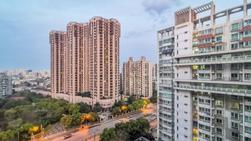 Residential buildings in Yangpu district in Shanghai, on March 23, 2020. (PHOTO / SIPA)
Residential buildings in Yangpu district in Shanghai, on March 23, 2020. (PHOTO / SIPA)
Investment in property development down
In addition, China's investment in property development went down 4 percent year-on-year in the first five months of 2022, Wednesday's data showed.
Investment in residential buildings came in at 3.95 trillion yuan, down 3 percent year-on-year
The total property investment in the period stood at 5.21 trillion yuan, the NBS said.
Investment in residential buildings came in at 3.95 trillion yuan, down 3 percent year-on-year.
ALSO READ: China's housing market keeps cooling, prices diverge
Commercial housing sales in terms of floor area totaled 507.38 million square meters in the first five months, down 23.6 percent year-on-year.
In terms of value, commercial housing sales fell 31.5 percent to 4.83 trillion yuan during the five-month period, according to the NBS.
The property development climate index compiled by the NBS came in at 95.6 points in May.
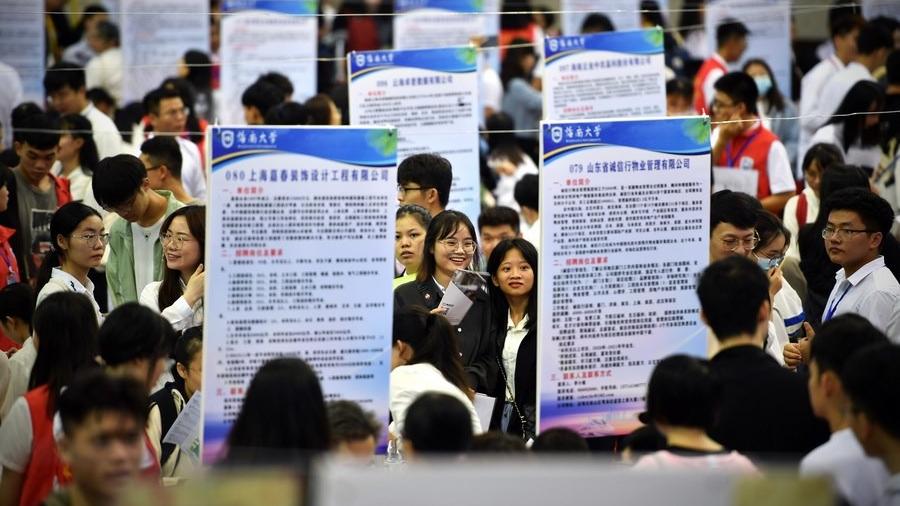 In this Oct 25, 2020 photo, graduates attend a job fair at Hainan University in Haikou, south China's Hainan province. (GUO CHENG / XINHUA)
In this Oct 25, 2020 photo, graduates attend a job fair at Hainan University in Haikou, south China's Hainan province. (GUO CHENG / XINHUA)
Urban unemployment rate down
The country's surveyed urban unemployment rate stood at 5.9 percent in May, down 0.2 percentage points from April.
A total of 5.29 million new urban jobs were created from January to May, data from the NBS showed.
The surveyed unemployment rate in 31 major cities came in at 6.9 percent in May, according to NBS data
In May, the surveyed urban unemployment rate among those aged between 25 and 59, the majority of the labor market, stood at 5.1 percent.
The surveyed unemployment rate in 31 major cities came in at 6.9 percent in May, according to the data.
The surveyed urban unemployment rate is calculated based on the number of unemployed people who have participated in the employment survey in urban areas, including migrant workers in cities.
READ MORE: China to unveil timely measures to stabilize employment
China aims to create over 11 million new urban jobs and keep a surveyed urban unemployment rate of no more than 5.5 percent in 2022, according to a government work report.


